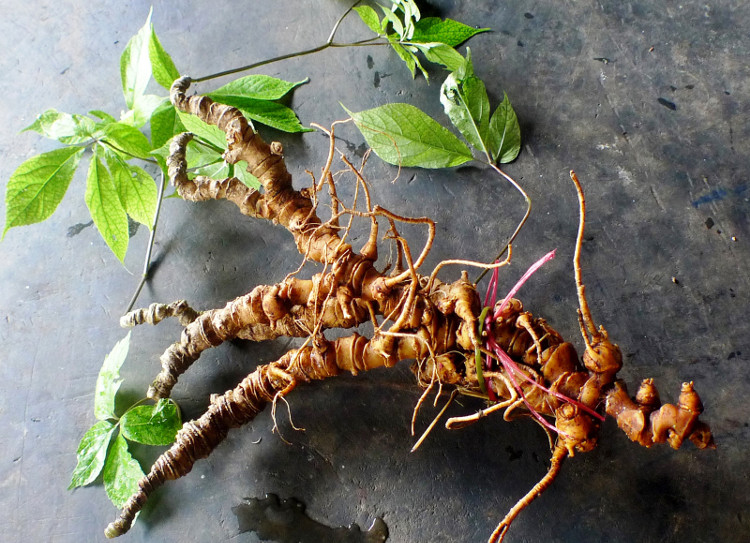Ngoc Linh Ginseng and what few people know
Finding Ngoc Linh ginseng is one of the most important discoveries in the field of medicine and pharmacy not only in Vietnam.
Ngoc Linh Ginseng - a rare and precious ginseng
Ngoc Linh Ginseng is a herbaceous species discovered in 1973 by the pharmaceutical investigation team of the Department of Civil Medicine at Ngoc Linh Mountain, belonging to 2 provinces of Kon Tum and Quang Nam. By 1985 two scientists (Dr. Ha Thi Dung and Dr. Grushvitsky) identified Ngoc Linh ginseng as a new, endemic species of Vietnamese flora, belonging to the genus Panax L., ginseng family (Araliaceae) and named Science is Panax vietnamensis Ha et Grushv (according to Vietnam Ginseng Center - 1993), belongs to 250 rare and precious species in Vietnam Red Book.
Only 2 provinces of Kon Tum and Quang Nam have Ngoc Linh ginseng and in 2 provinces there are only 5 districts, with 16 communes in Tu Mo Rong district (Kon Tum) and Nam Tra My district (Quang Nam). Panax. Ngoc Linh Peak with a height of 2,598 m is considered as the roof of the Central Highlands, with primitive forests along with the abundance of flora and fauna with natural conditions, especially suitable for the growth and development of ginseng. Ngoc Linh.
According to research results from 1978 of the Ministry of Health, Ngoc Linh Ginseng has a number of Saponins (one of the chemical components of herbs, is very effective for human health) many times higher. with other ginsengs in the world.

This is one of the ginseng types with the highest Saponin content.
The results of analysis of stem and root, tuber of Ngoc Linh ginseng, scientists determined that there are 52 types of Saponins, including 26 Saponins with chemical structure commonly found in Korean ginseng, American ginseng, Japanese ginseng. and 26 Saponins have a new structure, not in other ginseng types.
Thus, this is one of the ginseng types with the highest Saponin content. In addition, ginseng's surface parts such as leaves, stems (stalks) of Ngoc Linh have isolated 19 Saponin Dammaran, in which 8 Saponins have a new structure.
The use of Ngoc Linh ginseng
The studies have determined the pharmaceutical composition of Ngoc Linh Ginseng with 17 amino acids, 20 trace minerals and the concentration of essential oils is 0.1%.
Ngoc Linh Ginseng is effective as an energy-boosting, anti-aging drug, strengthening resistance, anti-toxin, stimulating the body's immune mechanism and supporting cancer prevention . Especially, Ngoc Linh ginseng has the features that ginseng some other countries do not have antibacterial, antidepressant, good synergies with antibiotics, drugs to treat diabetes .
Over the past 30 years, scientists at home and abroad have proved ginseng Ngoc Linh is a rare ginseng and is classified into one of the four best ginsengs in the world today, besides Korean ginseng, Chinese ginseng and American ginseng.
On August 16, 2016, the National Office of Intellectual Property issued a certificate of registration of geographical indication No. 00049 for Ngoc Linh's ginseng products in Mang Ri and Ngoc Lay communes of Tu Mo Rong district, Kon Tum province and commune. Tra Linh, Nam Tra My district, Quang Nam province, aims to widely inform domestic and foreign levels, organizations, businesses about the great value of Ngoc Linh ginseng in the market.
The Ministry of Science and Technology has approved an investment project of VND 567 billion in the period of 2014-2024 to build Ngoc Linh into a national product.
- Clonal seeds of Ngoc Linh ginseng
- Can dig Ngoc Linh ginseng 100 years old
- New success on clonal ginseng breeding
- Preserving and developing Ngoc Linh ginseng in Kon Tum
- Growing Ngoc Linh ginseng in ... 20 days
- 4 types of famous ginseng in the world
- Discovered another mountain peak with Ngoc Linh ginseng
- Ginseng forest is planted
- New cone-shaped leather frog in Ngoc Linh mountain
- Unexpected consequences when using ginseng in the wrong way
- The secret of world-class ginseng production, collecting billions of Korean dollars
- Dig ants to find rare and precious fungi, cost 68 million / kg
 Why do potatoes have eyes?
Why do potatoes have eyes? 'Tragedy' the world's largest carnivorous life: Death becomes ... public toilet
'Tragedy' the world's largest carnivorous life: Death becomes ... public toilet Tomatoes were once considered 'poisonous' for 200 years
Tomatoes were once considered 'poisonous' for 200 years Detecting microscopic parasites on human face
Detecting microscopic parasites on human face